Porter's Five Forces Model and Retail Industry Analysis
VerifiedAdded on 2020/07/22
|10
|2808
|64
AI Summary
The assignment provided is a detailed analysis of the retail industry using Porter's five forces model. It includes a review of relevant literature on the topic, as well as case studies and examples from companies such as Morrisons in the UK. The assignment also provides information on the turnover of Morrisons over several years. Overall, this document offers a comprehensive understanding of the retail industry through the lens of Porter's five forces model.
Contribute Materials
Your contribution can guide someone’s learning journey. Share your
documents today.
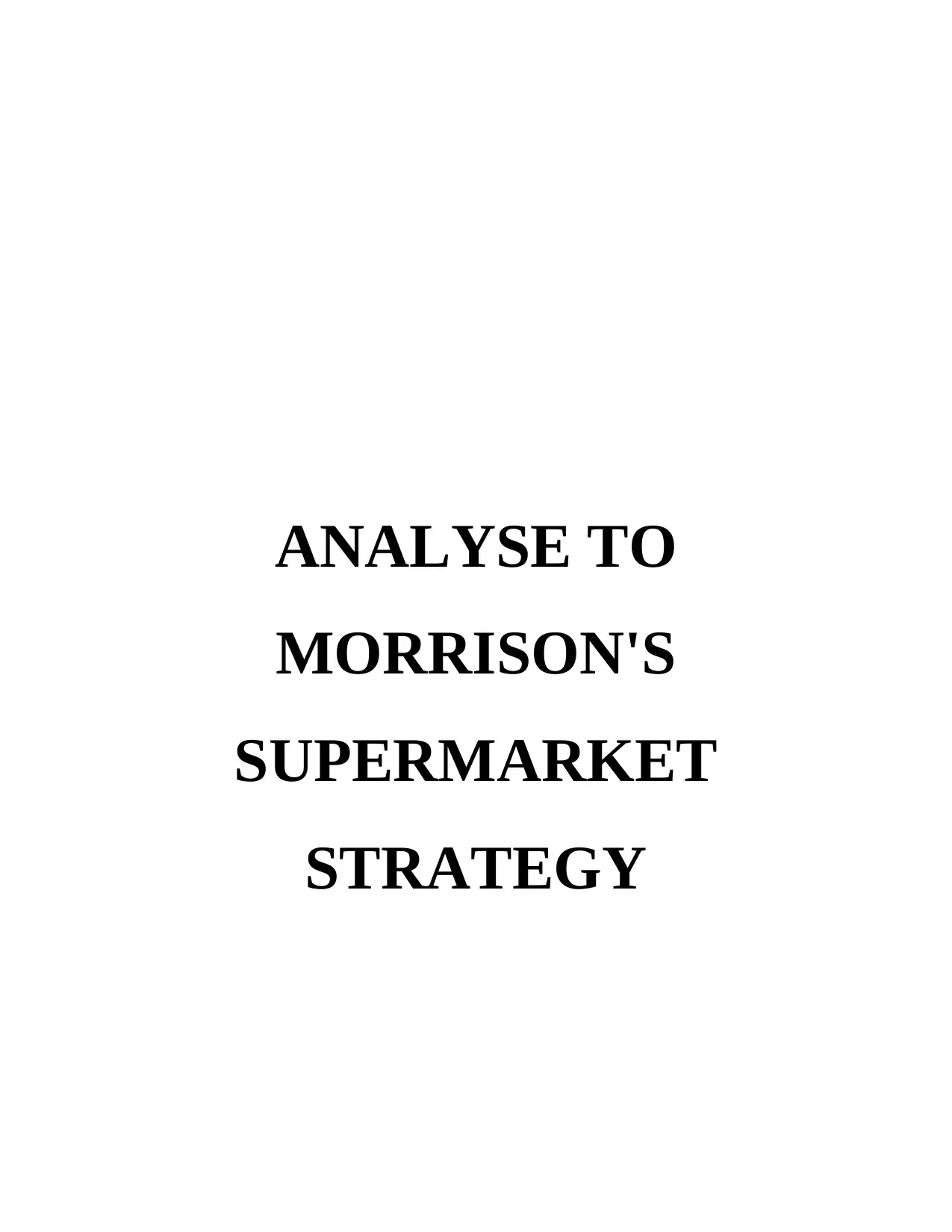
ANALYSE TO
MORRISON'S
SUPERMARKET
STRATEGY
MORRISON'S
SUPERMARKET
STRATEGY
Secure Best Marks with AI Grader
Need help grading? Try our AI Grader for instant feedback on your assignments.
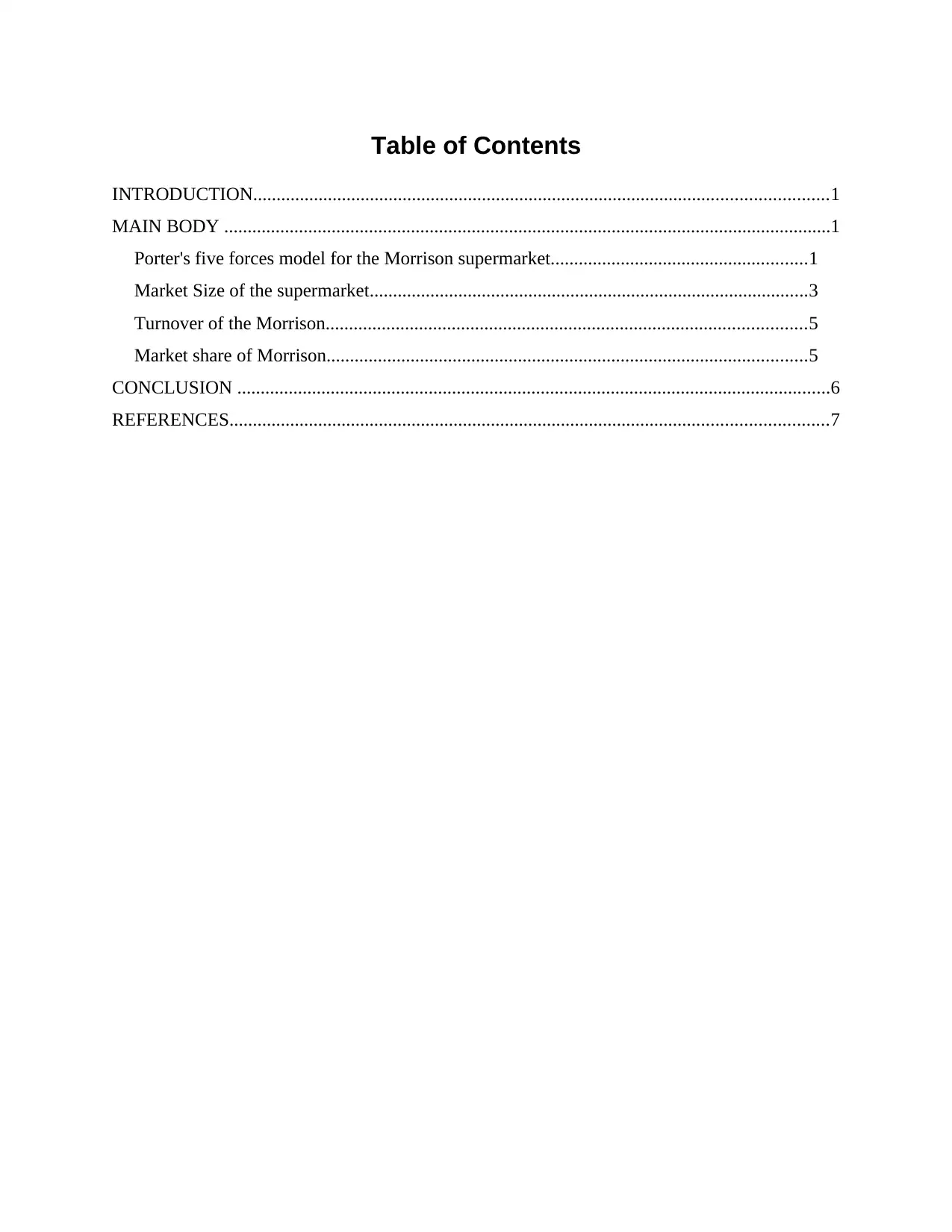
Table of Contents
INTRODUCTION...........................................................................................................................1
MAIN BODY ..................................................................................................................................1
Porter's five forces model for the Morrison supermarket.......................................................1
Market Size of the supermarket..............................................................................................3
Turnover of the Morrison.......................................................................................................5
Market share of Morrison.......................................................................................................5
CONCLUSION ...............................................................................................................................6
REFERENCES................................................................................................................................7
INTRODUCTION...........................................................................................................................1
MAIN BODY ..................................................................................................................................1
Porter's five forces model for the Morrison supermarket.......................................................1
Market Size of the supermarket..............................................................................................3
Turnover of the Morrison.......................................................................................................5
Market share of Morrison.......................................................................................................5
CONCLUSION ...............................................................................................................................6
REFERENCES................................................................................................................................7
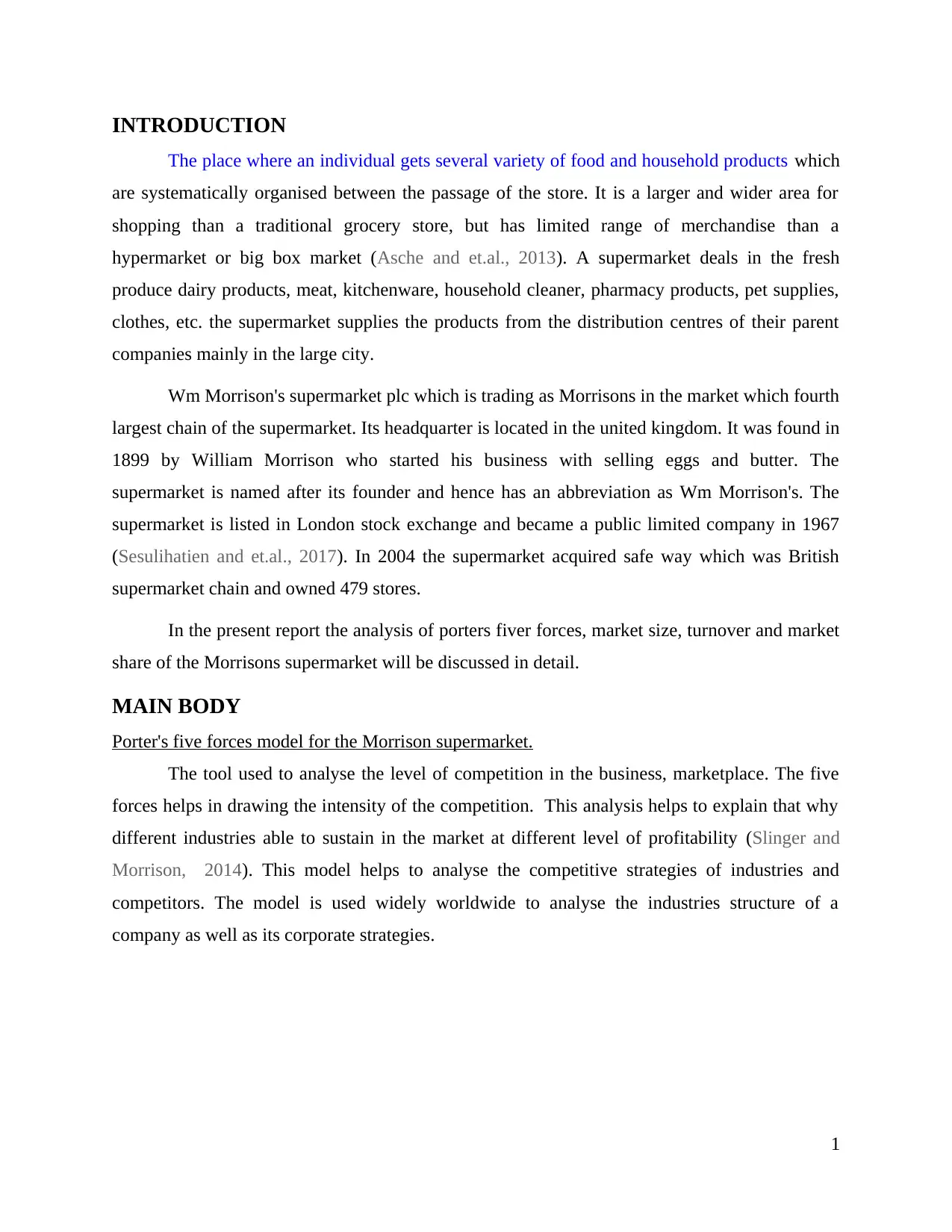
INTRODUCTION
The place where an individual gets several variety of food and household products which
are systematically organised between the passage of the store. It is a larger and wider area for
shopping than a traditional grocery store, but has limited range of merchandise than a
hypermarket or big box market (Asche and et.al., 2013). A supermarket deals in the fresh
produce dairy products, meat, kitchenware, household cleaner, pharmacy products, pet supplies,
clothes, etc. the supermarket supplies the products from the distribution centres of their parent
companies mainly in the large city.
Wm Morrison's supermarket plc which is trading as Morrisons in the market which fourth
largest chain of the supermarket. Its headquarter is located in the united kingdom. It was found in
1899 by William Morrison who started his business with selling eggs and butter. The
supermarket is named after its founder and hence has an abbreviation as Wm Morrison's. The
supermarket is listed in London stock exchange and became a public limited company in 1967
(Sesulihatien and et.al., 2017). In 2004 the supermarket acquired safe way which was British
supermarket chain and owned 479 stores.
In the present report the analysis of porters fiver forces, market size, turnover and market
share of the Morrisons supermarket will be discussed in detail.
MAIN BODY
Porter's five forces model for the Morrison supermarket.
The tool used to analyse the level of competition in the business, marketplace. The five
forces helps in drawing the intensity of the competition. This analysis helps to explain that why
different industries able to sustain in the market at different level of profitability (Slinger and
Morrison, 2014). This model helps to analyse the competitive strategies of industries and
competitors. The model is used widely worldwide to analyse the industries structure of a
company as well as its corporate strategies.
1
The place where an individual gets several variety of food and household products which
are systematically organised between the passage of the store. It is a larger and wider area for
shopping than a traditional grocery store, but has limited range of merchandise than a
hypermarket or big box market (Asche and et.al., 2013). A supermarket deals in the fresh
produce dairy products, meat, kitchenware, household cleaner, pharmacy products, pet supplies,
clothes, etc. the supermarket supplies the products from the distribution centres of their parent
companies mainly in the large city.
Wm Morrison's supermarket plc which is trading as Morrisons in the market which fourth
largest chain of the supermarket. Its headquarter is located in the united kingdom. It was found in
1899 by William Morrison who started his business with selling eggs and butter. The
supermarket is named after its founder and hence has an abbreviation as Wm Morrison's. The
supermarket is listed in London stock exchange and became a public limited company in 1967
(Sesulihatien and et.al., 2017). In 2004 the supermarket acquired safe way which was British
supermarket chain and owned 479 stores.
In the present report the analysis of porters fiver forces, market size, turnover and market
share of the Morrisons supermarket will be discussed in detail.
MAIN BODY
Porter's five forces model for the Morrison supermarket.
The tool used to analyse the level of competition in the business, marketplace. The five
forces helps in drawing the intensity of the competition. This analysis helps to explain that why
different industries able to sustain in the market at different level of profitability (Slinger and
Morrison, 2014). This model helps to analyse the competitive strategies of industries and
competitors. The model is used widely worldwide to analyse the industries structure of a
company as well as its corporate strategies.
1
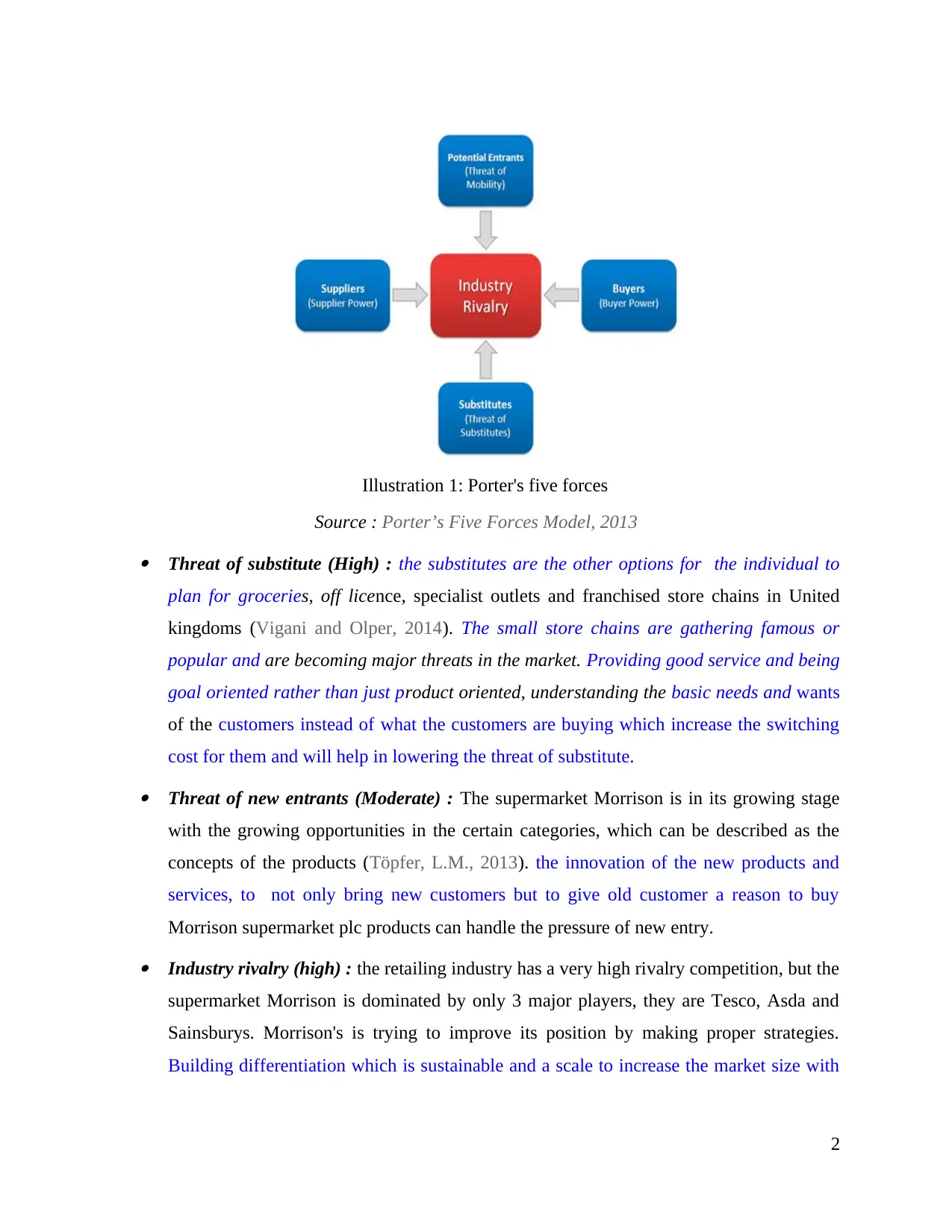
Source : Porter’s Five Forces Model, 2013 Threat of substitute (High) : the substitutes are the other options for the individual to
plan for groceries, off licence, specialist outlets and franchised store chains in United
kingdoms (Vigani and Olper, 2014). The small store chains are gathering famous or
popular and are becoming major threats in the market. Providing good service and being
goal oriented rather than just product oriented, understanding the basic needs and wants
of the customers instead of what the customers are buying which increase the switching
cost for them and will help in lowering the threat of substitute. Threat of new entrants (Moderate) : The supermarket Morrison is in its growing stage
with the growing opportunities in the certain categories, which can be described as the
concepts of the products (Töpfer, L.M., 2013). the innovation of the new products and
services, to not only bring new customers but to give old customer a reason to buy
Morrison supermarket plc products can handle the pressure of new entry. Industry rivalry (high) : the retailing industry has a very high rivalry competition, but the
supermarket Morrison is dominated by only 3 major players, they are Tesco, Asda and
Sainsburys. Morrison's is trying to improve its position by making proper strategies.
Building differentiation which is sustainable and a scale to increase the market size with
2
Illustration 1: Porter's five forces
plan for groceries, off licence, specialist outlets and franchised store chains in United
kingdoms (Vigani and Olper, 2014). The small store chains are gathering famous or
popular and are becoming major threats in the market. Providing good service and being
goal oriented rather than just product oriented, understanding the basic needs and wants
of the customers instead of what the customers are buying which increase the switching
cost for them and will help in lowering the threat of substitute. Threat of new entrants (Moderate) : The supermarket Morrison is in its growing stage
with the growing opportunities in the certain categories, which can be described as the
concepts of the products (Töpfer, L.M., 2013). the innovation of the new products and
services, to not only bring new customers but to give old customer a reason to buy
Morrison supermarket plc products can handle the pressure of new entry. Industry rivalry (high) : the retailing industry has a very high rivalry competition, but the
supermarket Morrison is dominated by only 3 major players, they are Tesco, Asda and
Sainsburys. Morrison's is trying to improve its position by making proper strategies.
Building differentiation which is sustainable and a scale to increase the market size with
2
Illustration 1: Porter's five forces
Secure Best Marks with AI Grader
Need help grading? Try our AI Grader for instant feedback on your assignments.
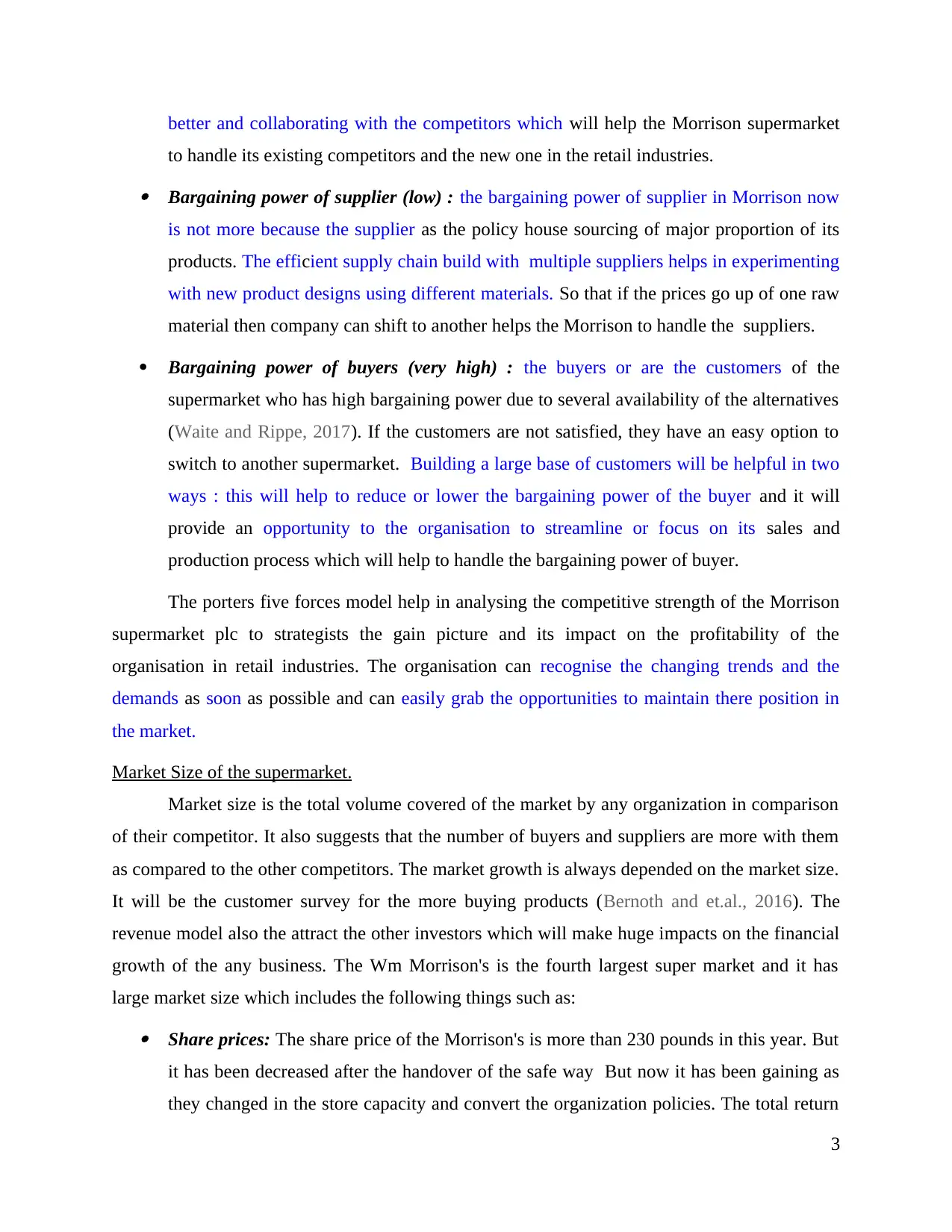
better and collaborating with the competitors which will help the Morrison supermarket
to handle its existing competitors and the new one in the retail industries. Bargaining power of supplier (low) : the bargaining power of supplier in Morrison now
is not more because the supplier as the policy house sourcing of major proportion of its
products. The efficient supply chain build with multiple suppliers helps in experimenting
with new product designs using different materials. So that if the prices go up of one raw
material then company can shift to another helps the Morrison to handle the suppliers.
Bargaining power of buyers (very high) : the buyers or are the customers of the
supermarket who has high bargaining power due to several availability of the alternatives
(Waite and Rippe, 2017). If the customers are not satisfied, they have an easy option to
switch to another supermarket. Building a large base of customers will be helpful in two
ways : this will help to reduce or lower the bargaining power of the buyer and it will
provide an opportunity to the organisation to streamline or focus on its sales and
production process which will help to handle the bargaining power of buyer.
The porters five forces model help in analysing the competitive strength of the Morrison
supermarket plc to strategists the gain picture and its impact on the profitability of the
organisation in retail industries. The organisation can recognise the changing trends and the
demands as soon as possible and can easily grab the opportunities to maintain there position in
the market.
Market Size of the supermarket.
Market size is the total volume covered of the market by any organization in comparison
of their competitor. It also suggests that the number of buyers and suppliers are more with them
as compared to the other competitors. The market growth is always depended on the market size.
It will be the customer survey for the more buying products (Bernoth and et.al., 2016). The
revenue model also the attract the other investors which will make huge impacts on the financial
growth of the any business. The Wm Morrison's is the fourth largest super market and it has
large market size which includes the following things such as: Share prices: The share price of the Morrison's is more than 230 pounds in this year. But
it has been decreased after the handover of the safe way But now it has been gaining as
they changed in the store capacity and convert the organization policies. The total return
3
to handle its existing competitors and the new one in the retail industries. Bargaining power of supplier (low) : the bargaining power of supplier in Morrison now
is not more because the supplier as the policy house sourcing of major proportion of its
products. The efficient supply chain build with multiple suppliers helps in experimenting
with new product designs using different materials. So that if the prices go up of one raw
material then company can shift to another helps the Morrison to handle the suppliers.
Bargaining power of buyers (very high) : the buyers or are the customers of the
supermarket who has high bargaining power due to several availability of the alternatives
(Waite and Rippe, 2017). If the customers are not satisfied, they have an easy option to
switch to another supermarket. Building a large base of customers will be helpful in two
ways : this will help to reduce or lower the bargaining power of the buyer and it will
provide an opportunity to the organisation to streamline or focus on its sales and
production process which will help to handle the bargaining power of buyer.
The porters five forces model help in analysing the competitive strength of the Morrison
supermarket plc to strategists the gain picture and its impact on the profitability of the
organisation in retail industries. The organisation can recognise the changing trends and the
demands as soon as possible and can easily grab the opportunities to maintain there position in
the market.
Market Size of the supermarket.
Market size is the total volume covered of the market by any organization in comparison
of their competitor. It also suggests that the number of buyers and suppliers are more with them
as compared to the other competitors. The market growth is always depended on the market size.
It will be the customer survey for the more buying products (Bernoth and et.al., 2016). The
revenue model also the attract the other investors which will make huge impacts on the financial
growth of the any business. The Wm Morrison's is the fourth largest super market and it has
large market size which includes the following things such as: Share prices: The share price of the Morrison's is more than 230 pounds in this year. But
it has been decreased after the handover of the safe way But now it has been gaining as
they changed in the store capacity and convert the organization policies. The total return
3
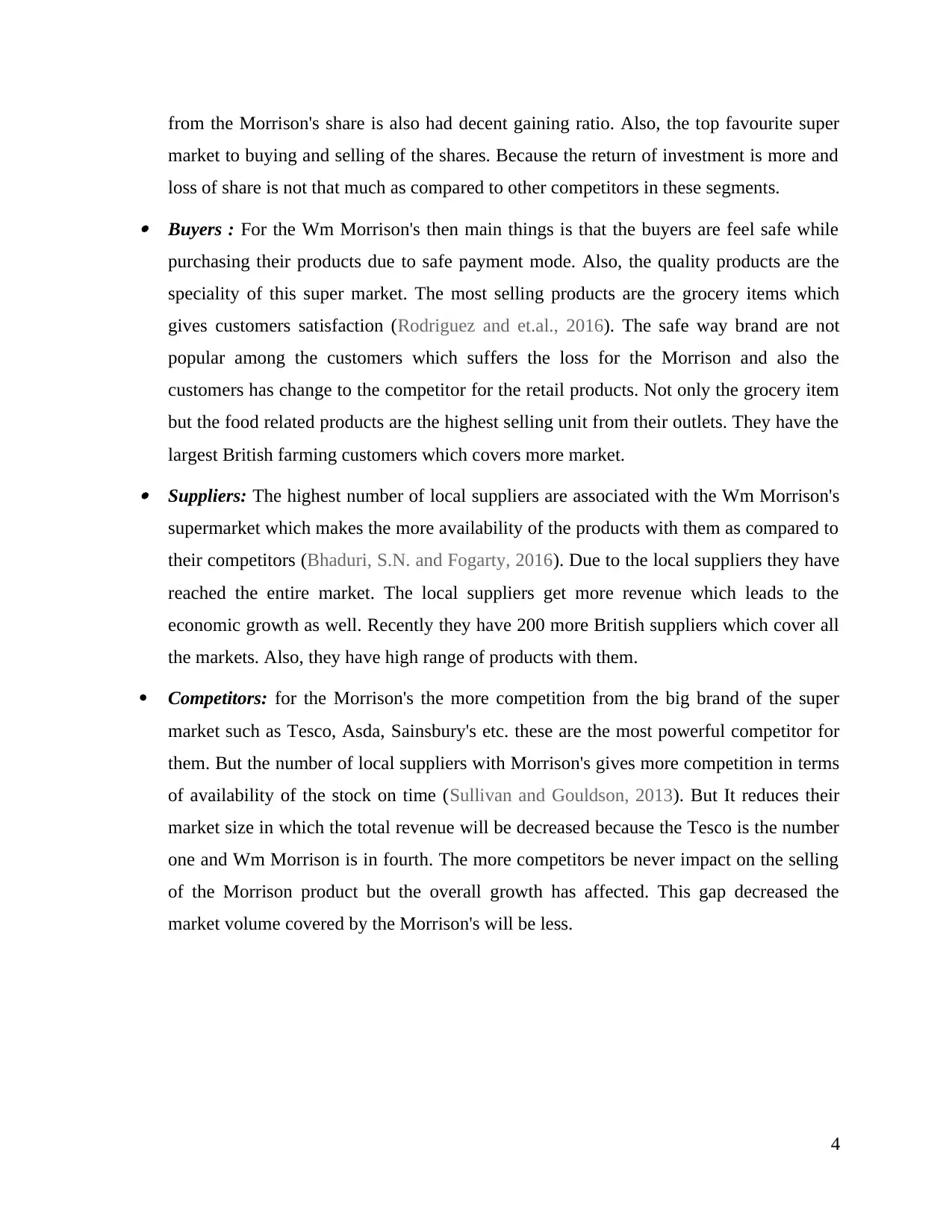
from the Morrison's share is also had decent gaining ratio. Also, the top favourite super
market to buying and selling of the shares. Because the return of investment is more and
loss of share is not that much as compared to other competitors in these segments. Buyers : For the Wm Morrison's then main things is that the buyers are feel safe while
purchasing their products due to safe payment mode. Also, the quality products are the
speciality of this super market. The most selling products are the grocery items which
gives customers satisfaction (Rodriguez and et.al., 2016). The safe way brand are not
popular among the customers which suffers the loss for the Morrison and also the
customers has change to the competitor for the retail products. Not only the grocery item
but the food related products are the highest selling unit from their outlets. They have the
largest British farming customers which covers more market. Suppliers: The highest number of local suppliers are associated with the Wm Morrison's
supermarket which makes the more availability of the products with them as compared to
their competitors (Bhaduri, S.N. and Fogarty, 2016). Due to the local suppliers they have
reached the entire market. The local suppliers get more revenue which leads to the
economic growth as well. Recently they have 200 more British suppliers which cover all
the markets. Also, they have high range of products with them.
Competitors: for the Morrison's the more competition from the big brand of the super
market such as Tesco, Asda, Sainsbury's etc. these are the most powerful competitor for
them. But the number of local suppliers with Morrison's gives more competition in terms
of availability of the stock on time (Sullivan and Gouldson, 2013). But It reduces their
market size in which the total revenue will be decreased because the Tesco is the number
one and Wm Morrison is in fourth. The more competitors be never impact on the selling
of the Morrison product but the overall growth has affected. This gap decreased the
market volume covered by the Morrison's will be less.
4
market to buying and selling of the shares. Because the return of investment is more and
loss of share is not that much as compared to other competitors in these segments. Buyers : For the Wm Morrison's then main things is that the buyers are feel safe while
purchasing their products due to safe payment mode. Also, the quality products are the
speciality of this super market. The most selling products are the grocery items which
gives customers satisfaction (Rodriguez and et.al., 2016). The safe way brand are not
popular among the customers which suffers the loss for the Morrison and also the
customers has change to the competitor for the retail products. Not only the grocery item
but the food related products are the highest selling unit from their outlets. They have the
largest British farming customers which covers more market. Suppliers: The highest number of local suppliers are associated with the Wm Morrison's
supermarket which makes the more availability of the products with them as compared to
their competitors (Bhaduri, S.N. and Fogarty, 2016). Due to the local suppliers they have
reached the entire market. The local suppliers get more revenue which leads to the
economic growth as well. Recently they have 200 more British suppliers which cover all
the markets. Also, they have high range of products with them.
Competitors: for the Morrison's the more competition from the big brand of the super
market such as Tesco, Asda, Sainsbury's etc. these are the most powerful competitor for
them. But the number of local suppliers with Morrison's gives more competition in terms
of availability of the stock on time (Sullivan and Gouldson, 2013). But It reduces their
market size in which the total revenue will be decreased because the Tesco is the number
one and Wm Morrison is in fourth. The more competitors be never impact on the selling
of the Morrison product but the overall growth has affected. This gap decreased the
market volume covered by the Morrison's will be less.
4

Turnover of the Morrison.
Source : Morrisons annual turnover in the United Kingdom from financial year 2009/2010 to
2016/2017 (in a million GBP), 2017
The graphical representation shows the annual turnover of supermarket Morrison in
United Kingdom from the financial year 2009/10 to 2016/17. The last financial year ended in the
January 2017 with the growth in annual revenues of 16.12 billion British pound. Presently,
Morrison is the fourth largest supermarket in united kingdom, followed by Tesco, Asda and
Sainsbury's of the big four grocery retailers (Hussein and et.al., 2016). The company took over
safe way supermarket in 2004 and the market was expanded throughout the country with the
importance of their products. The Morrison supermarket teamed up purely with the online
retailers Ocado in 2013 in order to launch its own online service. It also sale its own labelled
products online via Amazon Fresh, 2016 onwards.
Market share of Morrison.
Morrison has the strongest sales growth among the big four supermarkets. The big four
supermarkets are facing lose and are continuing to lose the market share as the shoppers has
started spending towards the grocery items due to rising prices. Wm Morrison's supermarket plc
is the leading companies among the big four supermarkets with the powerful sales growth in the
research of 12 weeks which started from 25 February (Chin, D., 2015). The information
collected by a firm shows that Morrison has attained a year increase in sales about 1.9% during
the period, for the evidence is about to start a new addition of fruit beer. Whereas, Tesco plc
5
Illustration 2: Turnover of Morrison
Source : Morrisons annual turnover in the United Kingdom from financial year 2009/2010 to
2016/2017 (in a million GBP), 2017
The graphical representation shows the annual turnover of supermarket Morrison in
United Kingdom from the financial year 2009/10 to 2016/17. The last financial year ended in the
January 2017 with the growth in annual revenues of 16.12 billion British pound. Presently,
Morrison is the fourth largest supermarket in united kingdom, followed by Tesco, Asda and
Sainsbury's of the big four grocery retailers (Hussein and et.al., 2016). The company took over
safe way supermarket in 2004 and the market was expanded throughout the country with the
importance of their products. The Morrison supermarket teamed up purely with the online
retailers Ocado in 2013 in order to launch its own online service. It also sale its own labelled
products online via Amazon Fresh, 2016 onwards.
Market share of Morrison.
Morrison has the strongest sales growth among the big four supermarkets. The big four
supermarkets are facing lose and are continuing to lose the market share as the shoppers has
started spending towards the grocery items due to rising prices. Wm Morrison's supermarket plc
is the leading companies among the big four supermarkets with the powerful sales growth in the
research of 12 weeks which started from 25 February (Chin, D., 2015). The information
collected by a firm shows that Morrison has attained a year increase in sales about 1.9% during
the period, for the evidence is about to start a new addition of fruit beer. Whereas, Tesco plc
5
Illustration 2: Turnover of Morrison
Paraphrase This Document
Need a fresh take? Get an instant paraphrase of this document with our AI Paraphraser
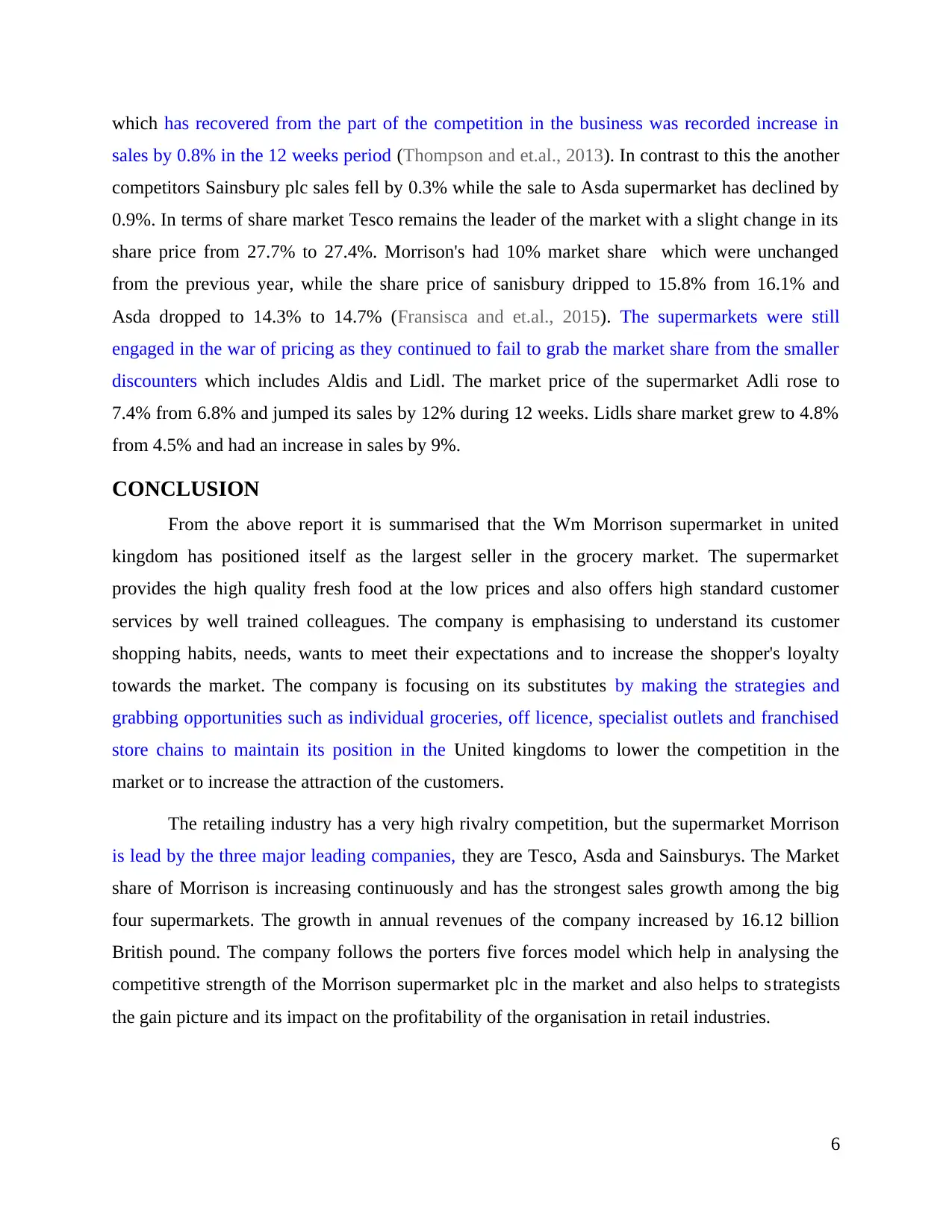
which has recovered from the part of the competition in the business was recorded increase in
sales by 0.8% in the 12 weeks period (Thompson and et.al., 2013). In contrast to this the another
competitors Sainsbury plc sales fell by 0.3% while the sale to Asda supermarket has declined by
0.9%. In terms of share market Tesco remains the leader of the market with a slight change in its
share price from 27.7% to 27.4%. Morrison's had 10% market share which were unchanged
from the previous year, while the share price of sanisbury dripped to 15.8% from 16.1% and
Asda dropped to 14.3% to 14.7% (Fransisca and et.al., 2015). The supermarkets were still
engaged in the war of pricing as they continued to fail to grab the market share from the smaller
discounters which includes Aldis and Lidl. The market price of the supermarket Adli rose to
7.4% from 6.8% and jumped its sales by 12% during 12 weeks. Lidls share market grew to 4.8%
from 4.5% and had an increase in sales by 9%.
CONCLUSION
From the above report it is summarised that the Wm Morrison supermarket in united
kingdom has positioned itself as the largest seller in the grocery market. The supermarket
provides the high quality fresh food at the low prices and also offers high standard customer
services by well trained colleagues. The company is emphasising to understand its customer
shopping habits, needs, wants to meet their expectations and to increase the shopper's loyalty
towards the market. The company is focusing on its substitutes by making the strategies and
grabbing opportunities such as individual groceries, off licence, specialist outlets and franchised
store chains to maintain its position in the United kingdoms to lower the competition in the
market or to increase the attraction of the customers.
The retailing industry has a very high rivalry competition, but the supermarket Morrison
is lead by the three major leading companies, they are Tesco, Asda and Sainsburys. The Market
share of Morrison is increasing continuously and has the strongest sales growth among the big
four supermarkets. The growth in annual revenues of the company increased by 16.12 billion
British pound. The company follows the porters five forces model which help in analysing the
competitive strength of the Morrison supermarket plc in the market and also helps to strategists
the gain picture and its impact on the profitability of the organisation in retail industries.
6
sales by 0.8% in the 12 weeks period (Thompson and et.al., 2013). In contrast to this the another
competitors Sainsbury plc sales fell by 0.3% while the sale to Asda supermarket has declined by
0.9%. In terms of share market Tesco remains the leader of the market with a slight change in its
share price from 27.7% to 27.4%. Morrison's had 10% market share which were unchanged
from the previous year, while the share price of sanisbury dripped to 15.8% from 16.1% and
Asda dropped to 14.3% to 14.7% (Fransisca and et.al., 2015). The supermarkets were still
engaged in the war of pricing as they continued to fail to grab the market share from the smaller
discounters which includes Aldis and Lidl. The market price of the supermarket Adli rose to
7.4% from 6.8% and jumped its sales by 12% during 12 weeks. Lidls share market grew to 4.8%
from 4.5% and had an increase in sales by 9%.
CONCLUSION
From the above report it is summarised that the Wm Morrison supermarket in united
kingdom has positioned itself as the largest seller in the grocery market. The supermarket
provides the high quality fresh food at the low prices and also offers high standard customer
services by well trained colleagues. The company is emphasising to understand its customer
shopping habits, needs, wants to meet their expectations and to increase the shopper's loyalty
towards the market. The company is focusing on its substitutes by making the strategies and
grabbing opportunities such as individual groceries, off licence, specialist outlets and franchised
store chains to maintain its position in the United kingdoms to lower the competition in the
market or to increase the attraction of the customers.
The retailing industry has a very high rivalry competition, but the supermarket Morrison
is lead by the three major leading companies, they are Tesco, Asda and Sainsburys. The Market
share of Morrison is increasing continuously and has the strongest sales growth among the big
four supermarkets. The growth in annual revenues of the company increased by 16.12 billion
British pound. The company follows the porters five forces model which help in analysing the
competitive strength of the Morrison supermarket plc in the market and also helps to strategists
the gain picture and its impact on the profitability of the organisation in retail industries.
6

REFERENCES
Books and Journals
Asche and et.al., 2013. Pricing of eco-labels for salmon in UK supermarkets.
Bernoth and et.al., 2016. The Impact of a Participatory Care Model on Work Satisfaction of Care
Workers and the Functionality, Connectedness, and Mental Health of Community-
Dwelling Older People. Issues in mental health nursing. 37(6). pp.429-435.
Bhaduri, S.N. and Fogarty, 2016. Strategic Retail Marketing Using DGP-Based Models.
In Advanced Business Analytics (pp. 57-70). Springer Singapore.
Chin, D., 2015. Supermarkets in Malyasia's Food Supply Chain: Influence on Traditional Supply
Chain and Implications for Contract Farmers. In 2015 Conference, August 9-14, 2015,
Milan, Italy (No. 211464). International Association of Agricultural Economists.
Fransisca and et.al., 2015. Assessment of arsenic in Australian grown and imported rice varieties
on sale in Australia and potential links with irrigation practises and soil
geochemistry. Chemosphere. 138. pp.1008-1013
Hussein and et.al., 2016, April. Hedonic Analysis of Origin of Meat In The United Kingdom.
In Contributed Paper Presented at 90th Annual Conference of the Agricultural
Economics Society, University of Warwick.
Rodriguez and et.al., 2016. Engaging diverse populations in biospecimen donation: results from
the Hoy y Mañana study. Journal of community genetics. 7(4). pp.271-277.
Sesulihatien and et.al., 2017. Building the vector-control collaborative strategy in Dengue Fever:
Case surabaya, Kuala Lumpur, Bangkok. Information Modelling and Knowledge Bases
XXVIII. 292. p.94.
Slinger, G. and Morrison, R., 2014. Will Organization Design Be Affected By Big Data?.
Sullivan, R. and Gouldson, A., 2013. Ten years of corporate action on climate change: What do
we have to show for it?. Energy Policy. 60. pp.733-740.
Thompson and et.al., 2013. Understanding interactions with the food environment: an
exploration of supermarket food shopping routines in deprived neighbourhoods. Health
& place. 19. pp.116-123.
7
Books and Journals
Asche and et.al., 2013. Pricing of eco-labels for salmon in UK supermarkets.
Bernoth and et.al., 2016. The Impact of a Participatory Care Model on Work Satisfaction of Care
Workers and the Functionality, Connectedness, and Mental Health of Community-
Dwelling Older People. Issues in mental health nursing. 37(6). pp.429-435.
Bhaduri, S.N. and Fogarty, 2016. Strategic Retail Marketing Using DGP-Based Models.
In Advanced Business Analytics (pp. 57-70). Springer Singapore.
Chin, D., 2015. Supermarkets in Malyasia's Food Supply Chain: Influence on Traditional Supply
Chain and Implications for Contract Farmers. In 2015 Conference, August 9-14, 2015,
Milan, Italy (No. 211464). International Association of Agricultural Economists.
Fransisca and et.al., 2015. Assessment of arsenic in Australian grown and imported rice varieties
on sale in Australia and potential links with irrigation practises and soil
geochemistry. Chemosphere. 138. pp.1008-1013
Hussein and et.al., 2016, April. Hedonic Analysis of Origin of Meat In The United Kingdom.
In Contributed Paper Presented at 90th Annual Conference of the Agricultural
Economics Society, University of Warwick.
Rodriguez and et.al., 2016. Engaging diverse populations in biospecimen donation: results from
the Hoy y Mañana study. Journal of community genetics. 7(4). pp.271-277.
Sesulihatien and et.al., 2017. Building the vector-control collaborative strategy in Dengue Fever:
Case surabaya, Kuala Lumpur, Bangkok. Information Modelling and Knowledge Bases
XXVIII. 292. p.94.
Slinger, G. and Morrison, R., 2014. Will Organization Design Be Affected By Big Data?.
Sullivan, R. and Gouldson, A., 2013. Ten years of corporate action on climate change: What do
we have to show for it?. Energy Policy. 60. pp.733-740.
Thompson and et.al., 2013. Understanding interactions with the food environment: an
exploration of supermarket food shopping routines in deprived neighbourhoods. Health
& place. 19. pp.116-123.
7
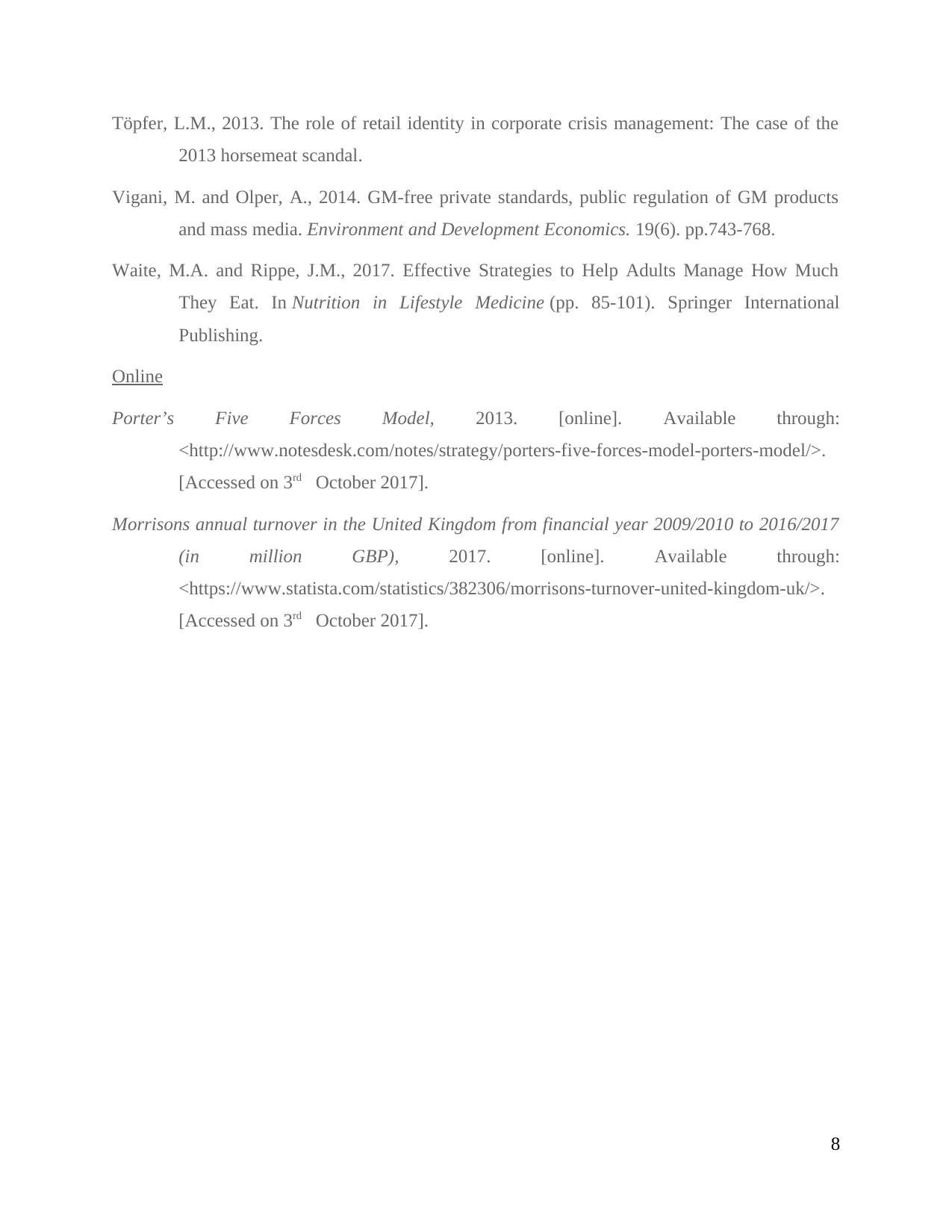
Töpfer, L.M., 2013. The role of retail identity in corporate crisis management: The case of the
2013 horsemeat scandal.
Vigani, M. and Olper, A., 2014. GM-free private standards, public regulation of GM products
and mass media. Environment and Development Economics. 19(6). pp.743-768.
Waite, M.A. and Rippe, J.M., 2017. Effective Strategies to Help Adults Manage How Much
They Eat. In Nutrition in Lifestyle Medicine (pp. 85-101). Springer International
Publishing.
Online
Porter’s Five Forces Model, 2013. [online]. Available through:
<http://www.notesdesk.com/notes/strategy/porters-five-forces-model-porters-model/>.
[Accessed on 3rd October 2017].
Morrisons annual turnover in the United Kingdom from financial year 2009/2010 to 2016/2017
(in million GBP), 2017. [online]. Available through:
<https://www.statista.com/statistics/382306/morrisons-turnover-united-kingdom-uk/>.
[Accessed on 3rd October 2017].
8
2013 horsemeat scandal.
Vigani, M. and Olper, A., 2014. GM-free private standards, public regulation of GM products
and mass media. Environment and Development Economics. 19(6). pp.743-768.
Waite, M.A. and Rippe, J.M., 2017. Effective Strategies to Help Adults Manage How Much
They Eat. In Nutrition in Lifestyle Medicine (pp. 85-101). Springer International
Publishing.
Online
Porter’s Five Forces Model, 2013. [online]. Available through:
<http://www.notesdesk.com/notes/strategy/porters-five-forces-model-porters-model/>.
[Accessed on 3rd October 2017].
Morrisons annual turnover in the United Kingdom from financial year 2009/2010 to 2016/2017
(in million GBP), 2017. [online]. Available through:
<https://www.statista.com/statistics/382306/morrisons-turnover-united-kingdom-uk/>.
[Accessed on 3rd October 2017].
8
1 out of 10
Related Documents
Your All-in-One AI-Powered Toolkit for Academic Success.
+13062052269
info@desklib.com
Available 24*7 on WhatsApp / Email
![[object Object]](/_next/static/media/star-bottom.7253800d.svg)
Unlock your academic potential
© 2024 | Zucol Services PVT LTD | All rights reserved.





